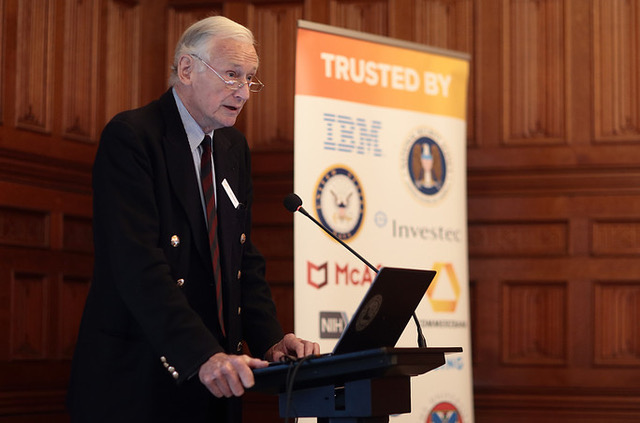ITProPortal speaks to Bridgeworks CEO, David Trossell, to take a closer look at how the digital revolution is re-defining the way organisations rely on technology.

June 30, 2017
How digital technology changes manufacturing
A recent study by Fujitsu finds that “digital is already making an impression on the manufacturing sector. It discovers that: “Nine in ten (90%) of manufacturing professionals surveyed in Fujitsu’s Fit For Digital study reported the technology sector has already been impacted by digital disruption, and 95% expect it to be further impacted in the future.” It adds that when the respondents looked at their own organisations, “95% admitted theirs needed to evolve to thrive and 90% believe the industry will fundamentally change by 2021.”
The report also claims that digital disruption is here to stay, arguing in its executive summary that it has become the “new normal” because it is re-defining the way organisations operate. “Revenue streams, processes, customer relationships: All [of these] have been transformed by digital disruption…and while business leaders are enthusiastic about the opportunities that digital is creating, many have concerns for the future – a future in which they see continued upheaval”, it says. Fear of change is a common factor that has existed throughout history, so it shouldn’t be surprising to hear that any kind of disruption worries the business leaders.
Risk of change
Change equates to risk – a dive into the unknown, but the risk of maintaining the status quo might be costlier in the long run than embracing the need for evolution because as the report says: “Customers are demanding digital, and business leaders are only too aware of the consequences of failing to meet that demand. As the pace of change continues to grow, so too does competition, and many organisations say that the only way to thrive in this hyper-speed environment is to evolve. But even the scale of evolution is changing, as entire industries and the organisations within them are transformed in the digital era.”
At the heart of this battle sits technology, and so the report asserts that the digital agenda is being driven by the boardroom. It says there is a need to deal with aging infrastructure because Fujitsu pronounces that it is a hindrance, and in some cases this certainly is true. It therefore argues that organisations aren’t afraid to make big changes from leadership to skills. Some of these changes might involve – say in manufacturing – equipment that holds up the production line, or eradicating manual business or manufacturing processes through automation.
Maximising infrastructure
Yet there are other cases where old IT infrastructure needn’t be immediately replaced by the latest and greatest in technology. Solutions such as PORTrockIT, for example, can enable manufacturers and other organisations to maintain their existing IT and network infrastructure while mitigating the impact caused by data and network latency. With it manufacturers can achieve data acceleration, and it can make your existing legacy infrastructure more efficient because buying a larger pipe won’t necessarily make your data and network fly faster. WAN optimisation also often fails to deliver what it sets out to promise, but with a data acceleration solution that uses machine learning even encrypted data can be sent and received fast.
Strategic support
The fourth tenet of the report finds that organisations need strategic support to succeed. This is particularly poignant as Fujitsu has discovered from its survey that 52% of the respondents said that their “business will not exist in [its] current form in 5 years’ time.
” For this reason, business leaders aim to capitalise on digital disruption and the opportunities it offers their businesses.”
Ignacio Cea, Chief Strategy and Innovation Officer at Bankia is cited as saying that the company’s digital initiatives are “led by a desire to better service our customers.” He supports co-creation to achieve this aim, claiming that innovation isn’t always achievable by one’s self. Indeed, even in manufacturing, a fresh pair of eyes can quicken change and make it more effective as well as efficient.
With this digital transformation comes smart factories, driven by the Internet of Things and smart robotics to drive down costs to improve efficiency. Research by Capgemini claims that smart factories will give a $500bn (£386bn) boost to the global economy by 2022. Silicon.co.uk journalist Sam Pudwell writes: “The [Capgemini] report states that the growth of smart factories will drive a 27% increase in manufacturing efficiency over the next 5 years…and the future smart factory features include collaborative robots, augmented reality components and predictive maintenance, which will all go towards increasing productivity and flexibility, while lowering operating costs”.
Factory 2.0
Digital transformation is creating Factory 2.0, and 21% of manufacturers expect their plants to be smart factories in sectors such as aerospace, industrial manufacturing and automotive. These sectors are expected to lead the way, but to keep up or to lead they will need to develop new skillsets to fill what could become a widening skills gap. So manufacturers need to prepare themselves for tomorrow to ensure they have a prosperous future – technology is but one aspect of the changes that they need to address. There are many more strategic threats, opportunities and that challenges to consider.
In August 2015, McKinsey and Company’s Brian Hartmann, William P. King, and Subu Narayanan wrote: “Industry and academic leaders agree that digital-manufacturing technologies will transform every link in the manufacturing value chain, from research and development, supply chain, and factory operations to marketing, sales, and service. Digital connectivity among designers, managers, workers, consumers, and physical industrial assets will unlock enormous value and change the manufacturing landscape forever.”
The authors added: “Many large manufacturers are starting to use data analytics to optimise factory operations, boosting equipment utilisation and product quality while reducing energy consumption. With new supply-network management tools, factory managers have a clearer view of raw materials and manufactured parts flowing through a manufacturing network, which can help them schedule factory operations and product deliveries to cut costs and improve efficiency. Smart, connected products are sending customer experience data to product managers to help them anticipate demand and maintenance needs and design better products. Players in a wide range of industries are deploying digital technologies in different ways to drive value.”
Therefore, data is at the heart of their enterprises, and it needs protecting to ensure that they can maintain efficient back-office, supply chain and manufacturing operations.
Pratt and Whitney
Kimberley Hagerty, Lean Transformation Manager at Pratt and Whitney’s Hot Section Module Center in the US, found that the company certainly had the technology to make “the most advanced jet propulsion system in the world”, but it lacked the “most advanced processes and systems that supported the manufacturing of that technology”. Brett Brune also says that, while citing her in his article ‘The Year of Living Digitally’ in smart manufacturing magazine SME on 15th May 2017, she attended a seminar on digital transformation and smart manufacturing in Huntsville, Alabama. She went there to learn about “the digital twin”, big data, smart manufacturing and Industry 4.0, and applied the tools to her work afterwards.
“By June, Hagerty had mapped out her requirements and was reaching out to service providers – scheduling benchmarking visits to firms [with] products and services that might work well for Pratt and Whitney.” As a result of this exercise she recruited shop-floor management specialists at the Forcam Academy to help her to address her company’s challenges.
They include the deployment of “1,000 machines in four different states to build one customer order for turbine blades and vanes”, he cites her as saying. This presents an enterprise-sized challenge of how she can gain visibility to the data involved. She needs access to the data and any related analysis of it in real-time across several different states. What about the results of her endeavours? Well, in 2010 East Hartford-based Pratt and Whitney – located in Connecticut, has ramped up its monthly production of military and commercial aerospace engines. In 2017 it has plans to double engine production again, and a significant increase in production is also planned through to 2024 – all of which wouldn’t have been previously possible.
Hagerty has helped the company to define digital transformation strategy by eliminating 20-year old manufacturing processes. She has enabled the company to re-align itself to offer what she calls a ‘complete value stream approach’. This means that the four keys tenets of planning have been consolidated: Strategic, Enterprise, Operational and Execution. “Only by connecting all of them can you really have an effective plan on what it is you’re going to produce, and optimise it based on customer demand”, she tells Brune. This approach enables every constituent part of the supply chain and of the value chain to talk with one voice. She links planning and scheduling to achieve this, and her analysis is supported by real-time interactive tools that require real-time data to ensure that the entire value stream operates accurately.
So to ensure that latency doesn’t affect her ability to receive, transmit and analyse real-time data, she might need to also consider using a data acceleration tool – one that can also permit her to back up and retrieve her data fast. That’s important because even in manufacturing disasters can strike without warning. So it important for companies like hers to consider ways of ensuring that when something does go wrong, they can continue to operate unabated.
Click here to read the full article on www.itproportal.com




